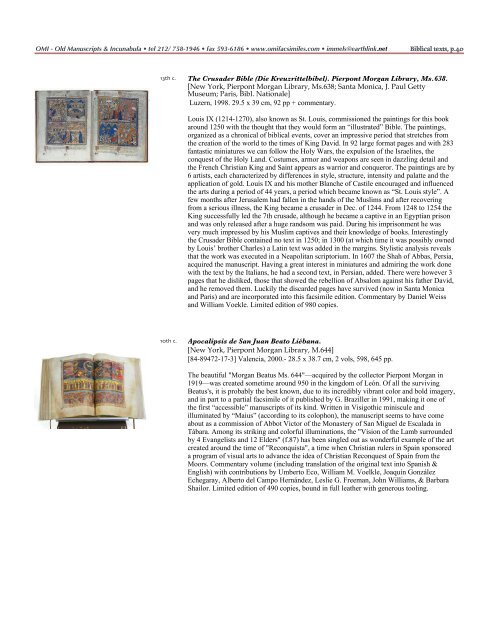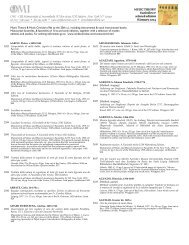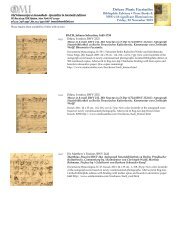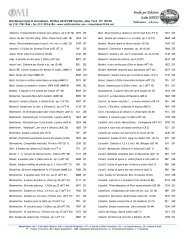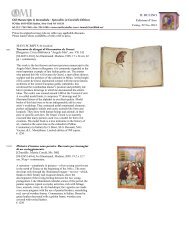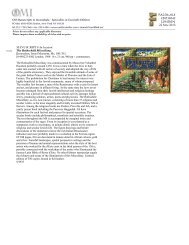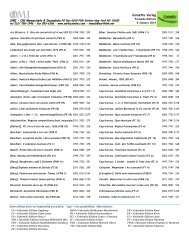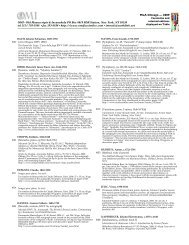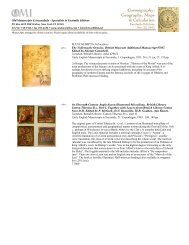Bibles & sacred texts - facsimiles - Omi
Bibles & sacred texts - facsimiles - Omi
Bibles & sacred texts - facsimiles - Omi
Create successful ePaper yourself
Turn your PDF publications into a flip-book with our unique Google optimized e-Paper software.
OMI - Old Manuscripts & Incunabula • tel 212/ 758-1946 • fax 593-6186 • www.omi<strong>facsimiles</strong>.com • immels@earthlink.net Biblical <strong>texts</strong>, p.40<br />
13th c. The Crusader Bible (Die Kreuzrittelbibel). Pierpont Morgan Library, Ms.638.<br />
[New York, Pierpont Morgan Library, Ms.638; Santa Monica, J. Paul Getty<br />
Museum; Paris, Bibl. Nationale]<br />
Luzern, 1998. 29.5 x 39 cm, 92 pp + commentary.<br />
Louis IX (1214-1270), also known as St. Louis, commissioned the paintings for this book<br />
around 1250 with the thought that they would form an “illustrated” Bible. The paintings,<br />
organized as a chronical of biblical events, cover an impressive period that stretches from<br />
the creation of the world to the times of King David. In 92 large format pages and with 283<br />
fantastic miniatures we can follow the Holy Wars, the expulsion of the Israelites, the<br />
conquest of the Holy Land. Costumes, armor and weapons are seen in dazzling detail and<br />
the French Christian King and Saint appears as warrior and conqueror. The paintings are by<br />
6 artists, each characterized by differences in style, structure, intensity and palatte and the<br />
application of gold. Louis IX and his mother Blanche of Castile encouraged and influenced<br />
the arts during a period of 44 years, a period which became known as “St. Louis style”. A<br />
few months after Jerusalem had fallen in the hands of the Muslims and after recovering<br />
from a serious illness, the King became a crusader in Dec. of 1244. From 1248 to 1254 the<br />
King successfully led the 7th crusade, although he became a captive in an Egyptian prison<br />
and was only released after a huge randsom was paid. During his imprisonment he was<br />
very much impressed by his Muslim captives and their knowledge of books. Interestingly<br />
the Crusader Bible contained no text in 1250; in 1300 (at which time it was possibly owned<br />
by Louis’ brother Charles) a Latin text was added in the margins. Stylistic analysis reveals<br />
that the work was executed in a Neapolitan scriptorium. In 1607 the Shah of Abbas, Persia,<br />
acquired the manuscript. Having a great interest in miniatures and admiring the work done<br />
with the text by the Italians, he had a second text, in Persian, added. There were however 3<br />
pages that he disliked, those that showed the rebellion of Absalom against his father David,<br />
and he removed them. Luckily the discarded pages have survived (now in Santa Monica<br />
and Paris) and are incorporated into this facsimile edition. Commentary by Daniel Weiss<br />
and William Voekle. Limited edition of 980 copies.<br />
10th c. Apocalipsis de San Juan Beato Liébana.<br />
[New York, Pierpont Morgan Library, M.644]<br />
[84-89472-17-3] Valencia, 2000.- 28.5 x 38.7 cm, 2 vols, 598, 645 pp.<br />
The beautiful "Morgan Beatus Ms. 644"—acquired by the collector Pierpont Morgan in<br />
1919—was created sometime around 950 in the kingdom of León. Of all the surviving<br />
Beatus's, it is probably the best known, due to its incredibly vibrant color and bold imagery,<br />
and in part to a partial facsimile of it published by G. Braziller in 1991, making it one of<br />
the first “accessible” manuscripts of its kind. Written in Visigothic miniscule and<br />
illuminated by “Maius” (according to its colophon), the manuscript seems to have come<br />
about as a commission of Abbot Victor of the Monastery of San Miguel de Escalada in<br />
Tábara. Among its striking and colorful illuminations, the "Vision of the Lamb surrounded<br />
by 4 Evangelists and 12 Elders" (f.87) has been singled out as wonderful example of the art<br />
created around the time of "Reconquista", a time when Christian rulers in Spain sponsored<br />
a program of visual arts to advance the idea of Christian Reconquest of Spain from the<br />
Moors. Commentary volume (including translation of the original text into Spanish &<br />
English) with contributions by Umberto Eco, William M. Voelkle, Joaquín González<br />
Echegaray, Alberto del Campo Hernández, Leslie G. Freeman, John Williams, & Barbara<br />
Shailor. Limited edition of 490 copies, bound in full leather with generous tooling.


